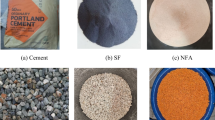Abstract
An experimental investigation was conducted to develop a low-carbon lightweight aggregate concrete (LWAC) using naturally occurring aggregates and evaluate its mechanical performance. Lightweight aggregates used in structural concrete are commonly manufactured from recycled pulverised fuel ash or expanded clay, which require high temperatures during production. Additionally, the availability of traditional supplementary cementitious materials used in concrete, such as Ground Granulated Blast Furnace Slag (GGBS), is diminishing. Therefore, more environmentally friendly alternatives are required. Pumice, a naturally occurring lightweight stone formed due to the rapid cooling of magma from volcanic eruptions, poses a promising candidate for using as lightweight aggregate, whilst it might also exhibit pozzolanic properties that make it suitable as a cement replacement material. Therefore, the present study is focused on examining the development of low-carbon LWAC mixes with pumice as coarse aggregate and ground pumice as cement replacement. In addition, a novel recycled waste known as Lytash was trialed as a filler. This is a by-product of the manufacture of fly-ash based lightweight aggregates (commonly known as Lytag, which is in itself is a recycled by-product from coal fired power plants). The fresh and hardened densities of concrete were evaluated as well as the compressive strength (targeting a strength class LC30/33). It was found that lightweight aggregate concrete with a density of less than 1800 kg/m3 was possible to achieve. Furthermore, the pozzolanic reactivity and X-Ray Diffraction (XRD) testing; as well as the 28 days compressive strength of samples tested revealed the potential of pumice powder to be used as a cement substitute. Embodied carbon calculations were also carried out accentuating the savings in carbon footprint that can be achieved with pumice aggregate and powder.
Access this chapter
Tax calculation will be finalised at checkout
Purchases are for personal use only
Similar content being viewed by others
References
Kanavaris, F., et al.: Reducing embodied carbon dioxide of structural concrete with lightweight aggregate. In: Proceedings of the Institution of Civil Engineers – Engineering Sustainability, Themed Issue on Advances in Sustainable Concrete, vol. 175, no. 2, pp. 75–83 (2022)
Praveen Kumar, F., Rajasekhar, S.: An Experimental study on light weight concrete by partial replacement of coarse aggregate by pumice stone and cement by GGBS. IJSRD – Int. J. Sci. Res. Dev. 4(9), 2321–0613 (2016)
Lambert, G.: Properties and behaviour of structural lightweight (Lytag – sand) concrete. PhD thesis (1982)
Collins, F., Sherwood, S.: Use of waste and recycled materials as aggregates: standards and specifications. HM Stationery Office, London, UK (1996)
Bilodeau, F., Kodur, S., Hoff, T.: Optimization of the type and number of polypropylene fibres for preventing the spalling of lightweight concrete subjected to hydrocarbon fire. Cement Concr. Compos. 26(2), 163–174 (2004)
Sin, L.F., Huan, W.S., Islam, M.T., Mansur, M.T.: Reinforced lightweight concrete beams in flexure. ACI Struct. J. 108, 3–12 (2011)
Muralitharan, F., Ramasamy, S.: Development of lightweight concrete for structural applications. J. Struct. Eng. (Madras) 44(4), 336–344 (2017)
Karthika, F., Vidyapriya, S., Nandhini Sri, T.: Experimental study on lightweight concrete using pumice aggregate. Mater. Today Proc. 43(2), 1606–1613 (2021)
BS EN 197-1:2011: Cement. Composition, specifications and conformity criteria for common cements. British Standards Institute, London, UK (2019)
BS EN 15167-1:2006: Ground granulated blast furnace slag for use in concrete, mortar and grout. Definitions, specifications and conformity criteria. British Standards Institute, London, UK (2006)
BS EN 12620:2013: Aggregates for concrete. British Standards Institute, London, UK (2013)
BS EN 934-6:2019: Admixtures for concrete, mortar and grout. Sampling, assessment, and verification of the constancy of performance. British Standards Institute, London, UK (2019)
Draft BS 8615-2:2018: Specification for pozzolanic materials for use with Portland cement: High reactivity natural calcined pozzolana. British Standards Institute, London, UK (2018)
BS EN 12350-5:2019: Testing fresh concrete. Slump-flow test. British Standards Institute, London, UK (2019)
BS EN 12350-6:2019: Testing fresh concrete. Density. British Standards Institute, London, UK (2019)
BS EN 12390-7:2019: Testing hardened concrete. Density of hardened concrete. British Standards Institute, London, UK (2019)
BS EN 12390-3:2019: Testing hardened concrete. Compressive strength of test specimens. BSI, London, UK (2019)
Li, F., Snellings, S., Antoni, T.: Reactivity tests for supplementary cementitious materials. RILEM TC 267-TRM Phase 1. Mater. Struct. 51(151), 1–14 (2018)
MPA: Embodied CO2e of UK cement additions, and cementitious material. Fact Sheet 18
Lava Mining & Quarrying SA: Pumice Stone Environmental Product Declaration No. S-P-02521 (2021)
Concrete4Change Homepage: Barriers to Net-Zero Concrete: Fly Ash and GGBS (2022). https://www.concrete4change.com/post/barriers-to-net-zero-concrete-fly-ash-and-ggbs-shortage. Accessed 27 Jan 2023
Al-Farttoosi, H., Abdulrazzaq, O., Hussain, T.: Mechanical properties of light weight aggregate concrete using pumice as a coarse aggregate. IOP Conf. Ser. Mater. Sci. Eng. 1090, 012106 (2021)
Hossain, K.: Properties of volcanic pumice based cement and lightweight concrete. Cem. Concr. Res. 34, 283–291 (2004)
Author information
Authors and Affiliations
Corresponding author
Editor information
Editors and Affiliations
Rights and permissions
Copyright information
© 2023 The Author(s), under exclusive license to Springer Nature Switzerland AG
About this paper
Cite this paper
Abbas, A., Mahadevan, M., Prajapati, S., Ayati, B., Kanavaris, F. (2023). Development of Low-Carbon Lightweight Concrete Using Pumice as Aggregate and Cement Replacement. In: Jędrzejewska, A., Kanavaris, F., Azenha, M., Benboudjema, F., Schlicke, D. (eds) International RILEM Conference on Synergising Expertise towards Sustainability and Robustness of Cement-based Materials and Concrete Structures. SynerCrete 2023. RILEM Bookseries, vol 44. Springer, Cham. https://doi.org/10.1007/978-3-031-33187-9_27
Download citation
DOI: https://doi.org/10.1007/978-3-031-33187-9_27
Published:
Publisher Name: Springer, Cham
Print ISBN: 978-3-031-33186-2
Online ISBN: 978-3-031-33187-9
eBook Packages: EngineeringEngineering (R0)




